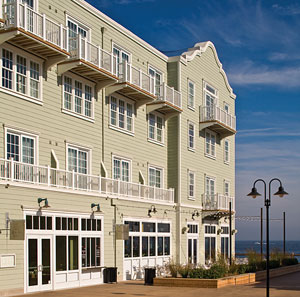Fiberglass Fenestration Comes into its Own
Vinyl
A vinyl window can be inexpensive, durable and energy-efficient when designed properly to minimize thermal transfer. While early vinyl windows had problems with thermal expansion (the vinyl sash would expand or contract at a different rate from the glass and cause leaks) and stability in very hot environments, modern vinyl windows are much more durable and dimensionally stable. Vinyl window frames with heat-welded joints are stiffer than mechanically joined vinyl frames and thus provide better resistance to temperature stresses. Interior webs also strengthen the frame and improve its thermal performance.
Vinyl windows are made primarily from polyvinyl chloride (PVC) which is virtually maintenance-free. Vinyl frames can't easily be painted, but are often available in white and various neutral colors that complement many design schemes. Because the color permeates the material, scratches and dings are nearly impossible to see. New technologies have enabled some vinyl window manufacturers to paint vinyl, however, they must choose from a limited color palette and have the correct paint formulation in order to prevent deformation of the vinyl due to heat buildup.
Quality varies by manufacturer and composition of the vinyl compound, which will dictate its performance over time. Each additive to a vinyl recipe helps determine the long-term characteristics of the final product, such as its weather and impact resistance; for example, titanium dioxide allows the product to weather better, thus preventing it from yellowing. Differences in the vinyl recipe used and how vinyl parts are formed will determine the structural strength and insulation performance.
Vinyl's characteristics include:
- Energy-efficient
- Durable
- Non-corroding
- Maintenance-free
- Available in a wide range of styles and shapes
- Cost-effective
- Easy-to-install
Aluminum
Cannery Row Hotel
Gets Fiberglass Window Treatment |
At California's InterContinental Clement Monterey Hotel, which opened in May 2008, fiberglass windows provided a variety of benefits. Comprised of two four-story buildings connected by an enclosed bridge over thriving tourist destination Cannery Row, the hotel features 208 guest rooms and suites luxuriously appointed with natural wood, marble and glass. Many of the rooms offer ocean views with some rooms directly over the water with panoramic views of Monterey Bay. Fiberglass sliding patio doors, single-hung and picture windows were specified to withstand the corrosive and moisture-laden air over many years of service-and were custom designed to recreate the aesthetic of vintage wood windows prevalent in the historic Cannery Row district. |
 |
A coastal California Hotel is an ideal environment for fiberglass windows. Photo: Tom Rider |
Because of their rigidity, durability and narrow frames, aluminum windows can be configured into a wide variety of combinations that maximize views. Aluminum windows are low-maintenance options, and will not rust or rot. They are available with tough anodized or baked-on finishes. The downside of aluminum windows in the past was the lack of energy efficiency. Aluminum readily conducts heat and cold. In cold weather, a building's heat seeps out through the sash and frame. Better quality aluminum windows are now available, equipped with thermal breaks that separate the interior and exterior surfaces of the window to improve energy efficiency.
Aluminum's characteristics include:
- Long-lasting, reliable operation
- Strong and durable
- Resists deterioration
- Narrow sight lines maximize view
- Slim frames complement modern architectural styles
- Durable factory-applied color options
Fiberglass
Used in marine and industrial applications for years, it is only recently that manufacturers have been able to produce the complex profiles required for window designs. As a window frame material, fiberglass is known for its strength, durability and performance. It is inherently chemical-resistant and impervious to water, cold, heat, insects, the corrosive effectives of salt air and pollutants and deterioration due to ultraviolet rays, moisture, rot, oxidation, rust-all the traditional enemies of windows and doors. While wood, and to a lesser extent, vinyl and aluminum windows, can result in problems with warping, rotting, cracking, bowing and shrinking, fiberglass has a lack of brittleness, deterioration of surface finish and the highest resistance to warping and twisting. Throughout any climatic environment, fiberglass stays rigid, stable, and practically maintenance-free. Unlike wood, fiberglass frames won't crack from dryness, swell, peel or warp.
Strength. Fiberglass provides the strongest window material, with experts maintaining it is some three times stronger than aluminum and nine times stronger than vinyl. According to the American Architectural Manufacturers Association (AAMA), fiberglass profiles have roughly the same strength as steel (based on tensile strength). Its strength enables fiberglass to be fabricated in large sizes, accommodating large expanses of glass without requiring added support or reinforcement, making large picture windows possible and energy-efficient.
High strength-to-weight ratio. Its light weight gives fiberglass a high strength-to-weight ratio, adding to its suitability for large, complex profiles-benefits in both maximizing daylighting and enhancing historical accuracy in restoration projects.









